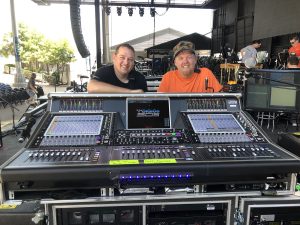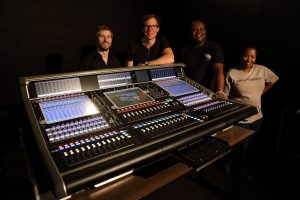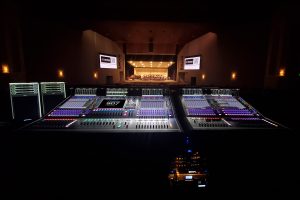Weird Al Yankovic, South Africa’s Splitbeam, Lake Travis ISD Performing Arts Center Recruit DiGiCo SD7 for Multiple Musical Acts
Story Highlights
The sound of “Weird Al” Yankovic’s latest North American tour is being managed by two DiGiCo SD5 consoles, supplied by Escondido, California-based SR vendor Sound Image. In addition, Splitbeam, the theater division of Gearhouse, South Africa’s largest rental company has invested in a DiGiCo SD7T supplied by DWR, DiGiCo’s distributor for the territory. Lastly, Northwest Austin school district also went with a DiGiCo SD7 desk for its main 1,500-seat theater and two SD9 consoles for the two additional performance spaces in the school’s performing arts center complex.
 Weird Al Yankovic
Weird Al Yankovic
Complementing the consoles are two 56-input SD-Racks and two SD-MiNi Racks, offering FOH engineer “Big Al” Rettich and monitor engineer Dana Beaudin plenty of functionality and flexibility for the tour’s high channel counts. In fact, Rettich says that the SD5’s input capacity was the main attraction for him.
“Originally, I looked at the DiGiCo SD12, but at the time it was limited to 70 paths, and we knew we were going to be well over a hundred inputs, so the SD5 was the natural fit,” he explains. “I love the SD5’s metering and the flexibility of the desk. On top of that, having three 12-channel banks is extremely helpful as I’m riding faders constantly while I’m hitting cues.”
This tour is Beaudin’s second time around on the desk. “I had moved to an SD5 for our tour last year, switching from another manufacturer,” he shares. “Going into this tour knowing that we would have all the inputs from the orchestra as well as some tracks, it was a no-brainer to go for the same console again, as it could easily handle the inputs. We are also sharing head-amp control on the racks to eliminate a split and keep the footprint of monitor world to a minimum.”
The cues — their number and complexity — are Rettich’s main management focus on the tour, which features local symphony orchestras at each tour stop, along with Yankovic’s longtime bandmates, Jim West (guitar), Steve Jay (bass), Ruben Valtierra (keys), and Jon “Bermuda” Schwartz (drums).
“For me, the biggest challenge is definitely hitting the cues,” he says. “Al wants to hear certain instruments pop in and out of songs, mainly the flutes and French horns, so having 36 faders in front of me so I’m not swapping between pages has been great. I also utilize the snapshots a lot. At 133 inputs, it’s difficult without using snapshots, so taking the time and perfecting my snapshots makes everything so much easier later. Plus, we’re going from theaters one night to sheds the next, and a different orchestra every night, and sometimes a 70-piece orchestra is a tight fit on a stage, so the SD5’s flexibility is a lifesaver.”
The snapshot feature is just as critical at monitors, says Beaudin, who contends nightly with virtually the entire band and crew on IEMs, plus sidefills for the orchestra and clicks for section lead players, for a total of 16 stereo and three mono mixes.
“Al and his band have been doing this for a long time and know what they want to hear in their mixes for each song, which can vary greatly from one minute to the next,” he says. “Having to make those changes without snapshots would be impossible. I also use a lot of macros, to talk to almost every person on stage, as well as for particular console moves I don’t want to do on a snapshot.”
“The Text Chat feature has also been a useful tool, letting Big Al and me update each other on things during rehearsals or the show,” Beaudin continues. “Copy Audio has additionally been useful as we have a new orchestra for almost every show. I run virtual soundcheck with the conductor and orchestra to rehearse the show without needing the band to come in for three hours every day. And being able to customize the layout of the desk to suit my needs is a huge benefit.”
The Rack systems further help keep a complex tour under control. Rettich says the two SD-Racks are “completely maxed with inputs,” so one SD-MiNi Rack is utilized for video lines and another as a backup for the video lines. “I have the SD-MiNi at FOH to allow me to digitally insert my Lake LM 44 system processors,” he says. “Being that we’re playing a mixture of sheds and theaters, I needed the flexibility of having system outputs either at FOH or onstage. Also, I’m using outputs to feed record outputs as well.”
What’s also making the job at FOH a bit easier are the SD5’s onboard processing and the integrated Waves plug-in processors. Rettich loves the Waves gear and regularly uses it; however, he adds, “I’ve now started to use the SD5’s multiband compressors and dynamic EQ,” he says, something that’s also helped the workflow. “I went from close to 60 plug-ins down to less than 30. The DiGiTubes add just a bit of grit and harmonic distortion that makes instruments pop nicely without adding a plug in.”
Rettich says this tour is the biggest one he’s ever helmed at FOH, but his SD5 makes it more than manageable. “There are things that Al might ask for that, if they can’t be done, we can’t blame that on the console because it can do pretty much anything you ask it to,” he quips. “But best of all, it sounds awesome. Al’s music depends on people getting the joke, so they have to hear every word clearly. We’re not traveling with a PA system, so the only consistent tool we have to do that with is the console, and it comes through clear as a bell, night after night.”
Splitbeam in South Africa
 The theater industry has its own demands and they differ from the other areas of the entertainment market. Sound is, of course completely crucial, and Splitbeam knows it has the right to be treated as top priority.
The theater industry has its own demands and they differ from the other areas of the entertainment market. Sound is, of course completely crucial, and Splitbeam knows it has the right to be treated as top priority.
“Bad sound is as detrimental to a production as an actor forgetting their lines,” says Splitbeam’s MD Alistair Kilbee. “Good sound feels natural, never taking away from what is happening on stage but supplementing it, giving the sound for the ears to match what the eyes see for the magic of theater to take place.
“Mixing sound is the art of balance; balancing what comes out of the speaker to transform a noise into a recognizable piece of information that feels good to experience. This is where the gear becomes important. Having a console capable of not merely handling the show, but orchestrating it, the engineer acting as the conductor for the sounds, matching, mixing and blending them to become an audible canvas.”
This is where Splitbeam makes it known that they take things seriously, and why they invested in a DiGiCo SD7T, the flagship console from DiGiCo that can perform under the most delicate of conditions, like the theater.
“The SD7T is immense,” continues Kilbee. “It boasts the features that sound engineers drool over: 253 (MAX) Input Channels, 128 Aux / Sub-Group Busses, L/R/LCR Master Buss, 32 x 32 Full Processing Matrix, two Solo 256 Dynamic Equalizers, 256 DiGiTuBes, 256 Multiband Compressors, 48 Digital FX, 32 Graphic Equalizers, optional Waves Integration, 48/96/192 kHz Sample Rate and one loop as standard optics. These features make it an exceptional instrument, and Splitbeam’s exceptional quality matches the quality of the machine.”
Currently being used on the musical production Chicago, the SD7T is performing at a world-class level.
“The theater is about crafting an experience that is both transformative and human,” Kilbee concludes. “As the audience’s senses are being stimulated, it becomes vital to understand that the sound is all about their enjoyment and journey. With the DiGiCo SD7T, it not only ensures this but shapes it. Splitbeam’s investment in the product co-signs it as a great console and as a great tool capable of producing great experiences and great art.”
 Lake Travis ISD Performing Arts Center
Lake Travis ISD Performing Arts Center
The Lake Travis Independent School District comprises its flagship Lake Travis High School and nine other middle and elementary schools, but what sets the LTISD apart is a theater-technology program on par with those at virtually any major university, along with a touring-class performing arts center to go with it. And in keeping with its mandate to “go with the best to be the best,” each of its theater spaces was equipped, after a technology upgrade last summer, with DiGiCo SD-Range consoles.
The Lake Travis ISD Performing Arts Center (LTPAC) consists of three theaters. A 1,500-seat Concert Hall featuring expansive support facilities—dressing rooms, rehearsal spaces, a scenic construction shop, and production shops—now features an SD7 with the recent Quantum engine upgrade. A Black Box Theater, with flexible seating for 250, and a 275-seat Recital Hall also have their own smaller SD9 desks. Three SD-Racks were additionally installed: one on a portable rack, another at stage left in the concert hall, and one that manages all of the venue’s digital and analog I/O in the central technology room. Austin-based Big House Sound supplied and installed all of the systems.
LTPAC facilities are supported by a staff of expertly trained student technicians in the Technical Theater Program at Lake Travis High School, which, including the introductory courses, has over 250 students enrolled. The new DiGiCo consoles represented LTPAC’s transition from analog consoles, and K.J. Bartosh, the venue’s managing director, says these consoles were the perfect choice for that and for introducing students to the same technology platforms they will encounter in the professional realm after graduation.
“Our mission is to arm our students with the best knowledge they need to pursue careers in professional theater, and the SD7 console is the leading audio console in professional theater,” states Bartosh. “When they leave here, they’ll be able to walk into the best theaters in the world ready to mix because the SD7 is what they’ll find in those theaters.”
As it turns out, the SD7 is also an exceptional teaching tool. One might assume that’s because the entire SD line’s ample use of touchscreen interfaces would be appealing to a class of Gen Z students who were brought up on that technology. However, Bartosh explains, the SD7 offers so much more as an instructional platform.
“At a time when audio consoles are getting smaller, putting more faders under layers of the work surface, the SD7 remains very much a fader-intensive console, which means we can get three or four students hands-on on the console at the same time during shows. The SD7 creates learning opportunities simply through its form factor. We also bought an expander section for the console, which adds faders and lets even more students interact with it.”
In addition, Bartosh continues, the SD-Range topography is scalable between models. Thus, students can move seamlessly between the theater spaces at the LTPAC. And the SD channel interface has a decidedly analog sense in its design. “When students use these consoles, the overall nature of signal path becomes totally clear to them,” he says.
The SD-Racks play a large part in the LTPAC’s new workflow. Bartosh recalls that ahead of the recent renovation, the architect informed them that enlarging the main theater’s small orchestra pit would entail substantial construction and cost. Thus, in the past, productions often had to use a truncated band for live music. Instead, at the suggestion of James Richardson, director of installations at Big House Sound, the orchestra now performs in an adjacent room, with enough space to comfortably fit the full orchestra, with tie lines between them and the stage, going through two SD-Racks as well as two-way video so actors and musicians can see each other in real time.
Bartosh, who credits DiGiCo/Group One’s Matt Larson and Big House Sound audio engineer Kyle Failla with generous ongoing training and support on the consoles, says that as amazing as the Core2-equipped SD consoles have been, the SD7’s performance has become even more spectacular with the January addition of the Quantum engine upgrade.
“You notice it immediately, with the speed with which the console starts up,” he says. “It’s exponentially faster. And now we can use the MADI ports for our iMac computers over a single USB cable. So many more possibilities.”
And the possibilities are what are proving the long-term value of the SD-Range consoles at the Technical Theater Program at Lake Travis High School. “The kids are learning the desks so quickly that they’re coming to me and making suggestions about new ways that we can use them,” he marvels. “Pretty soon, they’ll be teaching me.”
